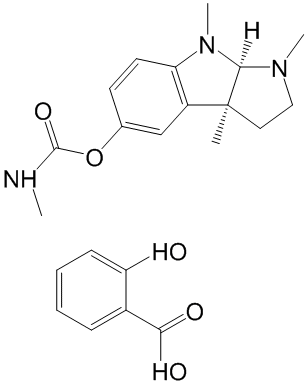
Physostigmine is a parasympathomimetic alkaloid, specifically, a reversible cholinesterase inhibitor.
| Cell Experiment | |
|---|---|
| Cell lines | Human erythrocyte |
| Preparation method | Starting at maximum enzyme activity (t=30), erythrocyte AChE was inhibited with a short pulse (4 min) of physostigmine (250 nM) followed by a continuous perfusion of physostigmine (50 nM) for 30 min. |
| Concentrations | 50 nM |
| Incubation time | 30 min |
| Animal Experiment | |
|---|---|
| Animal models | Sprague–Dawley rats |
| Formulation | |
| Dosages | 0.1–0.4mg/kg |
| Administration | i.v. |
| Molecular Weight | 413.47 |
| Formula | C15H21N3O2.C7H6O3 |
| CAS Number | 57-64-7 |
| Form | Solid |
| Solubility (25°C) | DMSO 10 mM |
| Storage |
Powder -20°C 3 years ; 4°C 2 years In solvent -80°C 6 months ; -20°C 1 month |
| Species | Mouse | Rat | Rabbit | Guinea pig | Hamster | Dog |
| Weight (kg) | 0.02 | 0.15 | 1.8 | 0.4 | 0.08 | 10 |
| Body Surface Area (m2) | 0.007 | 0.025 | 0.15 | 0.05 | 0.02 | 0.5 |
| Km factor | 3 | 6 | 12 | 8 | 5 | 20 |
| Animal A (mg/kg) = Animal B (mg/kg) multiplied by | Animal B Km |
| Animal A Km |
For example, to modify the dose of Compound A used for a mouse (20 mg/kg) to a dose based on the BSA for a rat, multiply 20 mg/kg by the Km factor for a mouse and then divide by the Km factor for a rat. This calculation results in a rat equivalent dose for Compound A of 10 mg/kg.
| Related AChR/AChE Products |
|---|
| Tacrine
Tacrine is a potent acetylcholinesterse (AChE) inhibitor (IC50=109 nM), also acting as a CYP1A2 substrate agent. |
| THRX-160209
THRX-160209 is a potent antagonist at the M(2) muscarinic acetylcholine (ACh) receptor subtype that was designed using a multivalent strategy, simultaneously targeting the orthosteric site and a nearby site known to bind allosteric ligands. |
| Catestatin
Catestatin is a 21-amino acid residue, cationic and hydrophobic peptide. |
| α-Conotoxin MII
α-Conotoxin MII (α-CTxMII), a 16-amino acid peptide from the venom of the marine snail Conus magus, potently blocks nicotinic acetylcholine receptors (nAChRs) composed of α3β2 subunits, with an IC50 of 0.5 nM. |
| COG 133 TFA
COG 133 TFA is a fragment of Apolipoprotein E (APOE) peptide. |


Products are for research use only. Not for human use. We do not sell to patients.
© Copyright 2010-2023 AbMole BioScience. All Rights Reserved.
